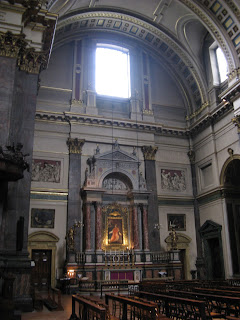The London Oratory was founded in 1849, the year after John Henry Newman established the Birmingham Oratory, by Frederick Faber and some companions. However, it was not until 1854 that the community moved to its present site, then the outskirts of London, described by Father Faber as "The Madeira of London". By contrast, today sees its nestled amongst trendy stores and coffee bars, a quick stroll from Harrods, with the constant bustling of London traffic outside and the rumbling of tube trains beneath. The
present church was consecrated in 1884 built to the design of a recent convert, Herbert Gribble, although the facade on the south end was not finished until 1893 and the dome
completed in 1895. Building the Oratory cost £93,000 with a further £14,000 spent during the next decade. Until the opening of Westminster Cathedral in 1903, the London Oratory was the venue for all great Catholic occasions in London, including
the funeral of Cardinal Manning in 1892. The Oratory is both internally and externally, a splendid building but the decoration we see today owes much to an Italian architect and local resident, Commandatore CTG Formilli who both designed and carried out the work between 1927-1932. The Oratory is dedicated to the Immaculate Heart of Mary.
Oratory Church
View of the North Transept and Pulpit
Mater Dolorosa Chapel
S. Philippo Neri Altar
Our Lady's Altar, originally from the Chapel of the Rosary in the Church of San Domenico, Brescia
Central Dome
Sacred Heart Chapel
West End of Nave
St. Peter and Newman Shrine
Arch, Entableture, Nave Window
St. Wilfred's Chapel
St. Wilfred's Chapel
St. Wilfred's Altar
Fr. Faber's Monument
Dome in St. Wilfred's Chapel
Side Altar and Tomb
Funerary Chapel in St. Wilfred's Chapel
Side Altar in St. Wilfred's Chapel
Side Altar of the English Martyrs
Our Lady of Mount Carmel Altar
Towards the Rear
Side view of Our Lady's Altar from St. Wilfred's Chapel



































































9 comments:
The creation of shrines for the veneration of the faithful is an important element of our experience of the Catholic Faith. It is a very natural and human instinct to recall those who are gone or who are absent but important to us before an image of them. With a shrine to the Saints we can honour their image as the representation of a fellow Catholic who has been a faithful image of Christ upon earth and is now our advocate in Heaven. I value the pictures in this article because they bring me to a closer appreciateion of Blessed John Newman.
Very impressive Church. Just shows what Blessed John has done for the Church.
Does anyone know who is buried in the tomb in the Chapel of St. Wilfred? It's enough to make death desirable if I could have my mortal remains marked by a monument such as that.
We owe 'Just a Girl' a great deal for her efforts on the blog - and also in the forthcoming issue of CHRISTVS REGNAT.
I also was struck by the recumbent figure that seems to have a cloth laid over her head. It is a particularly fine sculpture, especially when you think of the medium. It shows the advances in marble sculpture that reached its height in the Victorian age.
God bless you!
It is a beautiful church and the detail is amazing. Glad that the posts and the pictures are of interest but I definitely urge people to visit if they can to fully appreciate both the atmosphere and the decoration.
Even the chapel is a stunning church. It is a very dark place to have a shrine to Blessed Newman.
There is an undeniable englishness about the oratorians but is there some explanation for the distinct Romanism of the oratory? Was Newman averse to Sarum and the English Church? The inability to restore Sarum for centuries coupled with an anxiety to avoid the appearance of Anglicanism, even to the extent of a perculiar byzantine pile at Westminster, must have been a crushing influence upon the convert Newman. Even the Ordinariate, that could so easily have attempted to reclaim the Sarum heritage, has gone for a very Roman liturgy.
Its like something out of a fairy tale. Fab!
The ever excellent Mr. Cusack has a number of interesting posts on the Church of the London Oratory.
http://www.andrewcusack.com/tag/brompton-oratory/
Post a Comment